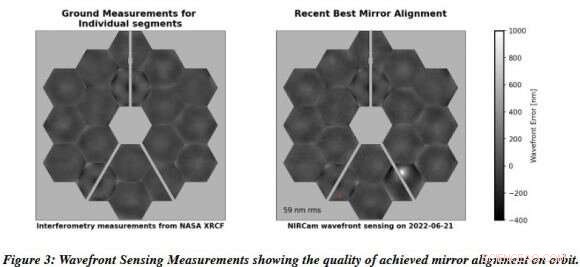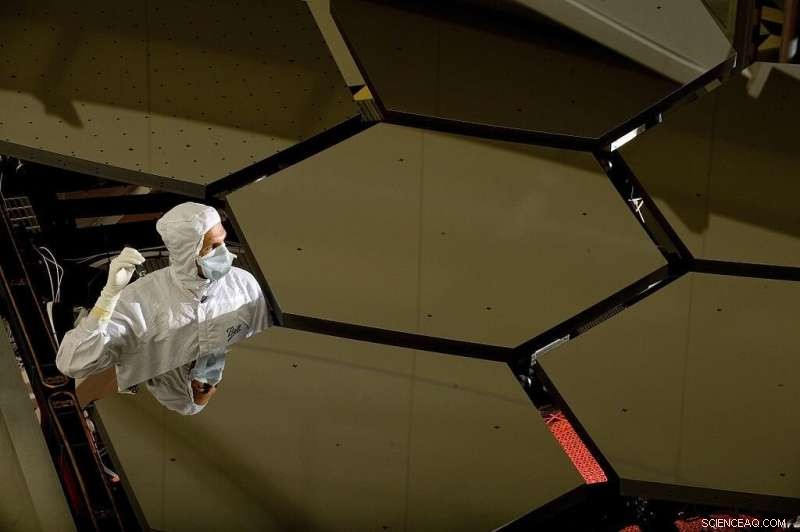
Confronto degli allineamenti speculari di Webb, tratto dal rapporto "Characterization of JWST science performance from commissioning" (12 luglio 2022). Credito:NASA/ESA/CSA
Il mondo è ancora sconvolto dal rilascio delle prime immagini del James Webb Space Telescope (JWST). Questi hanno fornito una panoramica completa del tipo di operazioni scientifiche che Webb condurrà nel corso della sua missione ventennale. Hanno incluso lo sguardo più sensibile e dettagliato ad alcuni oggetti astronomici iconici, spettri dall'atmosfera di un esopianeta e una visione a campo profondo di alcune delle galassie più distanti dell'universo. Dal loro rilascio, abbiamo anche avuto l'opportunità di vedere scorci di oggetti nel sistema solare catturati dagli strumenti a infrarossi di Webb.
Nel frattempo, la collaborazione JWST ha pubblicato un rapporto completo intitolato "Caratterizzazione delle prestazioni scientifiche JWST dalla messa in servizio", in cui hanno esaminato tutto ciò che Webb ha realizzato finora e ciò che prevede durante la missione. Questo documento è apparso di recente online e copre tutto, dalla navigazione del telescopio e indicando le prestazioni dei suoi numerosi strumenti. Una curiosità interessante, che non è stata rilasciata in precedenza, è come Webb ha subito una serie di impatti di micrometeoroidi, uno dei quali ha causato "cambiamenti non correggibili" in un segmento speculare.
Il team dietro questo studio comprendeva ricercatori delle tre agenzie spaziali partecipanti - NASA, Agenzia spaziale europea (ESA) e Agenzia spaziale canadese (CSA) - e di numerose agenzie partner della missione. Questi includono lo Space Telescope Science Institute (STScI), il Niels Bohr Institute, il Max-Planck-Institut für Astronomie (MPIA), il UK Astronomy Technology Center (UK ATC), il National Research Council Canada (NRCC), l'Instituto Nacional de Técnica Aeroespacial (INTA), il Centro de Astrobiologia (CAB) e molte aziende aerospaziali, università, istituti di ricerca e agenzie in tutto il mondo.
Il documento che hanno compilato valuta le prestazioni del JWST durante il periodo di messa in servizio di sei mesi prima che entrasse in servizio il 12 luglio 2022. Ciò consisteva nel caratterizzare le prestazioni in orbita dell'osservatorio, il design e l'architettura del JWST e le prestazioni previste prima del lancio. Questi sono stati quindi confrontati con le prestazioni della navicella spaziale, dei telescopi, degli strumenti scientifici e del sistema di terra. La sezione 4 del rapporto, Performance ottica, illustra il funzionamento dei vari strumenti Webb durante il periodo di messa in servizio.

Un segmento speculare primario del telescopio spaziale James Webb, fatto di berillio. Credito:NASA/MSFC/David Higginbotham/Emmett Given
Lo specchio primario del JWST è costituito da diciotto segmenti esagonali disposti in una configurazione a nido d'ape. Ogni segmento è composto da berillio placcato in oro e tutti sono allineati per garantire la massima risoluzione e sensibilità possibile. Le prestazioni complessive sono misurate in termini di Wavefront Error (WFE), che si riferisce al modo in cui la luce raccolta dagli specchi del telescopio devia dalla lunghezza d'onda prevista della luce. L'estensione complessiva è determinata calcolando la deviazione della luce raccolta dall'errore Root-Mean-Square (RMS), la media sferica dell'intero fronte d'onda.
Questo è espresso matematicamente usando le unità della particolare lunghezza d'onda, misurata in nanometri (nm) quando si tratta di lunghezze d'onda dell'infrarosso. La sezione 4.7 affronta gli impatti dei micrometeoroidi e il loro potenziale effetto sulle prestazioni ottiche a lungo termine di Webb. La valutazione inizia ricordando ai lettori che qualsiasi veicolo spaziale incontrerà inevitabilmente micrometeoroidi, quindi elenca i diversi impatti previsti durante il periodo di messa in servizio:
"Durante la messa in servizio, il rilevamento del fronte d'onda ha registrato sei deformazioni superficiali localizzate sullo specchio primario che sono attribuite all'impatto dei micrometeoroidi. Queste si sono verificate a una velocità (circa una al mese) coerente con le aspettative pre-lancio. Ogni micrometeoroide ha causato il degrado nel fronte d'onda del impacted mirror segment, as measured during regular wavefront sensing. Some of the resulting wavefront degradation is correctable through regular wavefront control; some of it comprises high spatial frequency terms that cannot be corrected."
They further indicate that these micrometeoroid impacts were detected so far through wavefront sensing. Five of the six detected impacts had negligible effects, contributing to a combined total of less than 1 nanometer to the overall wavefront error. However, the remaining impact, which occurred between May 22nd and May 24th, caused a "significant uncorrectable change" in the overall figure of segment C3. This segment is located on the lower right side of Webb's primary mirror (when seen from the front), and the effect is illustrated in the Report (see image above).
Luckily, the overall effect was small since only a small portion of the telescope area was affected by it. The mission teams also conducted two realignment steps to correct for the impact, which brought the telescope alignment to a minimum of 59 nm RMS, which is about 5 to 10 nm above the previous best wavefront error RMS values. The authors of the Report also go on to note that "drifts and stability levels" in the telescope typically result in a "telescope contribution" of between 60 (minimum) to 80 nm RMS—at which point, wavefront control is typically performed.
They also explain that it is unknown at this time whether or not the May 2022 impact to segment C3 was rare or something that can be expected to happen frequently throughout JWST's mission. As they state, this is essential if the JWST mission teams hope to determine if the telescope will be more susceptible to damage by micrometeoroids than pre-launch modeling predicted:
"The project team is conducting additional investigations into the micrometeoroid population, how impacts affect beryllium mirrors, and the efficacy and efficiency tradeoffs of potential mitigations such as pointing restrictions that would minimize time spent looking in the direction of orbital motion, which statistically has higher micrometeoroid rates and energies."
To summarize, the impact on the C3 segment raised concerns among the mission controllers. But the upside is that it was nothing they couldn't address and is not expected to affect Webb's long-term science operations. As the Report summarizes:
"The key outcome of six months of commissioning is this:JWST is fully capable of achieving the discoveries for which it was built. JWST was envisioned 'to enable fundamental breakthroughs in our understanding of the formation and evolution of galaxies, stars, and planetary systems'… we now know with certainty that it will. The telescope and instrument suite have demonstrated the sensitivity, stability, image quality, and spectral range that are necessary to transform our understanding of the cosmos through observations spanning from near-earth asteroids to the most distant galaxies."
Moreover, the Report's authors conclude that the JWST's performance has been better than expected, almost across the entire board. In terms of the optical alignment of its mirrors, the point spread function, the time-stability of its imaging, and the fine guidance system that points the observatory, Webb has exceeded expectations. They also indicate that the mirrors are cleaner, and the science instruments have generally provided higher total system throughput than pre-launch expectations. All of this adds up to some optimistic appraisals:
"Collectively, these factors translate into substantially better sensitivity for most instrument modes than was assumed in the exposure time calculator for Cycle 1 observation planning, in many cases by tens of percent. In most cases, JWST will go deeper faster than expected. In addition, JWST has enough propellant on board to last at least 20 years."
The JWST Collaboration stated that further details will be presented in a planned series of papers. These will appear in a special issue of the Publications of the Astronomical Society of the Pacific (PASP) dedicated to the JWST. + Esplora ulteriormente